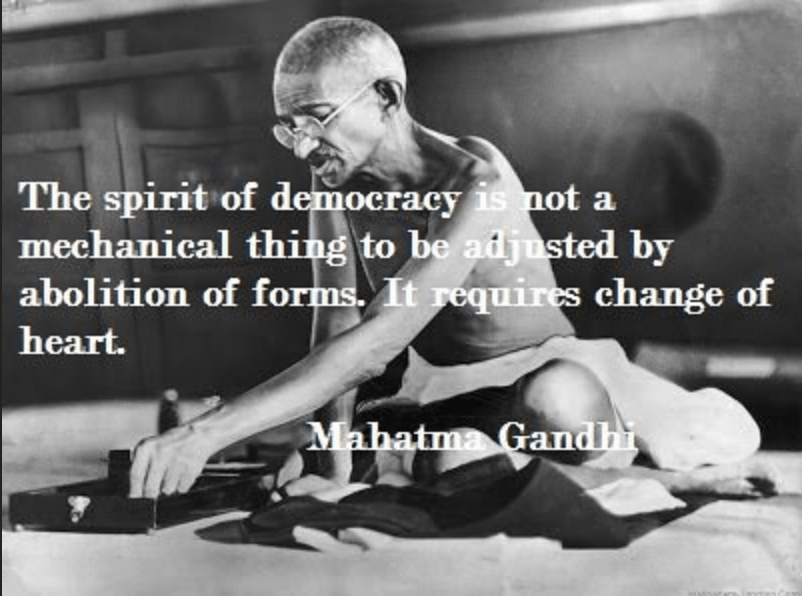One cold winter night in May 1893, a train screeched to a halt in a station. A swarm of passengers boarded the engine on a journey to Pretoria, South Africa; among the crowd was a young and eager lawyer with a first class ticket. He sat in the seat designated by the voucher he held in his hand. Upon departure, the young lawyer’s darker complexion caught the attention of a white passenger. The white man objected that a ‘colored’ man was allowed to sit in first class, on what was then, a segregated train. When questioned regarding the seat, the lawyer provided his voucher and identification to confirm he was in the proper place. Nevertheless, the comptroller physically removed the young Indian lawyer from the compartment and abandoned him in Pietermaritzburg.1 The young man was left out in the chilly winter night, but this act of racism ignited a flame deep within the freezing body of young lawyer, Mahatma Gandhi. He made the conscious decision to stay in South Africa, and combat racial discrimination in what would be his first fight for human rights.

At the turn of the twentieth century, South Africa was engulfed in a war between Boers and Brits, sparked by the conflict between British imperial interests and local Boer nationalism (from descendants of Dutch settlers).2 Boers are decendants of the Dutch that reside in South Africa.3 Gandhi saw, the Second Boer War, as it is often commonly referred to, as an opportunity to pledge allegiance to the Empire; he organized a group of African born Indians as stretcher-bearers to aid fallen British troops in the war zone. Gandhi aspired to gain equality for Indians within the South African society as British subjects, a limited integration into a white society.4 The violent conflict between the Boers and Brits led to the signing of the Treaty of Vereeniging in 1902. The peace treaty settled the affairs between the South African Republic and the Orange Free State on one side and the United Kingdom on the other.5 However, this did not change racially discriminatory practices in the whole region.

Even worse, in July 1907, the South African government passed an ordinance called the Black Act.This required Indians to be fingerprinted, registered, and to carry identification cards at all times, and failure to do so was punishable by prison, heavy fines, or deportation.6 By this time, Gandhi had realized his overreaching life goal of saradaya which means the “welfare of all” and or “to lift of all”. The Indian terms describing these principles are satya (truth), ahimsa (nonviolence), and tapasya, (selfsuffering).7 Gandhi used this idea in response to the Black Act. He and other members of the satyagraha (truth and nonviolent disobedience) movement picketed outside of the registration offices; these actions led to the arrest of the leaders of the movement.8 This was Gandhi’s first arrest for disobedience; he was sentenced on January 10, 1908, to two months of simple imprisonment.9 This was the first of six arrests in South Africa; three of with involving failure to produce registration.10
Throughout his time in South Africa, Gandhi worked tirelessly to improve the rights of immigrant Indians like him. This is where he developed and practiced his creed of passive resistance.11 His efforts paved the way for a change in policy. In fact, the Gandhian influence dominated freedom struggles on the African continent right up to the 1960s because of the power it generated and the unity it forged among the usually powerless. Nonviolence was the official stance of all major African coalitions, and the South African African National Congress (ANC) remained implacably opposed to violence for most of its existence.12 South Africa because of apartheid was placed on the agenda of the United Nations for the first time in 1946 by India regarding the treatment of people of Indian origin living in South Africa.13 South Africa’s apartheid policies clearly violated provisions of the U.N. Charter and human rights instruments adopted pursuant to it.14. Apartheid has also negatively impacted relations between the Republic of South Africa and India because of the subordinate status of people of Indian decent in South Africa.15 The General Assembly highlighted the deficit of the Universal Declaration of Human Rights in the apartheid policy within South Africa. Thanks to the work of Gandhi and satyagraha, the world took notice of inequalities caused by South African discriminatory policies.

South Africa was the land of the unfortunate encounter with institutional racism for Mahatma Gandhi. He found and established values in which he could fight against racial discrimination and civil rights violations for the rest of his life. Gandhi sated, “during ten years, that is, until 1914, excepting the intervals of my enforced rest in prison, there was hardly an issue of Indian Opinion without an article from me… the journal became for me a training in self-restraint, and for friends a medium to keep in touch with my thoughts.”16 He spent ten years living in South Africa, fighting for human rights, and writing about his journey for the Indian Opinion, an experience and self reflection triggered by the discrimination Indians faced in South Africa. He used adversity to shape his determination and mindset and framework of nonviolence for his future endeavors including India’s independence from the United Kingdom.
- “Gandhi in South Africa,” April 17, 2013, Maps of India. ↵
- Ashwin Desai and Goolam H Vahed, The South African Gandhi: Stretcher-Bearer of Empire, (Stanford University Press, 2015), 19. ↵
- Encyclopedia Britannica Online, s.v. “Boer,” by Shiveta Singh, last modified 2014. ↵
- Ashwin Desai and Goolam H Vahed, The South African Gandhi: Stretcher-Bearer of Empire, (Stanford University Press, 2015), 20. ↵
- Encyclopedia Britannica Online, s.v. “Peace of Vereeniging South Africa 1902,” by Darshana Das, last modified 2019. ↵
- Annette Barnabas & Paul Sundararajan Clifford, “Mahatma Gandhi – An Indian Model of Servant Leadership,” International Journal of Leadership Studies 7, no.2 (2012): 132-146. ↵
- Daniel M. Mayton II, “Gandhi as Peacebuilder: The Social Psychology of Satyagraha,” Peace, Conflict, and Violence: Peace Psychology for the 21st Century, (2001): 1-19. ↵
- Annette Barnabas & Paul Sundararajan Clifford, “Mahatma Gandhi – An Indian Model of Servant Leadership,” International Journal of Leadership Studies 7, no.2 (2012):132-146. ↵
- George Hendrick, The Influence of Thoreau’s ‘Civil Disobedience’ on Gandhi’s Satyagraha, (The New England Quarterly, 1957), 29. ↵
- “Years of Arrests & Imprisonment of Mahatma Gandhi,” 2005. ↵
- Richard Attenborough, The Words of Gandhi (HarperCollins, 1999), 39-42. ↵
- Nelson Mandela, “The Sacred Warrior,” Time Magazine, December 31, 1999, 1. ↵
- “South Africa and the United Nations 1946-1990,” South African History Online, https://www.sahistory.org.za/article/south-africa-and-united-nations-1946-1990. ↵
- United Nations, Charter of the United Nations, (1945). ↵
- Arthur J. Goldberg, “The Status of Apartheid under International Law,” Law Journal Library 13, no.1 (1985): 1-8. ↵
- Mohandas K. Gandhi, Autobiography: The Story of my Experiments with Truth, (1927), 326. ↵



42 comments
Aleea Costilla
I really enjoyed reading the story of Gandhi and his very own struggles with racism that sparked his passive resistance. The history of South African politics and their fight against discrimination of which I did not know. Thus the background and policies such as the Black Act formed understandable reasoning of Gandhi’s journey. Nonetheless, I believe the ideals presented by such an inspirational man helped establish headway for advocacy on discrimination, and this story helps enlighten such awareness.
Eric Grant
This is great work, Savannah. I love the vignette at the beginning. It almost sounds like something that could turn into the intro scene to a biopic film for Mahatma Gandhi. “The Black Act” that was passed by the South African government sounds a lot like the German government’s policy of forcing Jews to wear an identifying badge prior to WW2. I am a huge advocate of passive resistance and satyagraya, a notion that Gandhi championed (as you state in your essay).
Andres Garcia
Everyone knows about Gandhi’s monumental work as an activist of active nonviolent disobedience and protest, but this is the first time I learn about his earlier work. I had no idea that Gandhi was a lawyer working hard to overturn the discrimination in South Africa. In these unprecedented times where people seem more divided than ever before, I think to myself ” what would Gandhi do if he were alive today”. I’m sure he would emphasize the nonviolent aspect of protesting and call for people to refrain from burning buildings/ cars/ land. I hope more people can take inspiration by how Gandhi helped change the institutional racism in South Africa while still being nonviolent in his battle.
Jakob Trevino
This post really captures the leadership and major role that Gandhi had put out for the Indian Community. You can see the senseless acts that the government played in the freedom fight by Gandhi. The Black Act had a forthcoming of racism in South Africa which enabled the government to be able to freely dismantle the Indian and Black community that resided in South Africa, Gandhi wanted welfare for all and he would not stop until this issue was resolved.
Yamel Herrera
I think this article beautifully captured Gandhi’s road to leadership. It’s interesting that even today, there is still this issue that like the Black Act mentioned in this article, minorities are also being asked today to provide their forms of identification along the border cities. I think this article could benefit if it included a comparison between Gandhi’s “creed of passive resistance” and Martin Luther King Jr.’s four steps for nonviolent civil disobedience.
Victor Rodriguez
I really enjoyed this article. His non-violent philosophy is very inspiring and motivational. I believe that it is these types of leaders that set an example in society to how to make a change in this world. Using only non-violent protest, Gandhi was able to fight for justice and advocate for civil rights in India. It is astounding how he was bale to bring peace and civil rights back to the entire nation of India. He ended the unfair treatments and abuses done.
Alexandria Garcia
Understanding the influence Gandhi had on Martin Luther King Jr and the Civil Rights movement in America, gave this article even more value! I think it is amazing how far non-violence can bring a civilization that is combating violence and racism. I think it is sad that no matter your status (lawyer) and no matte how much money you have (the ability to sit in first class), one of color during Gandhi’s time and even our own cannot be treated fairly. It really makes you wonder, “What will it take?”. I also enjoyed how this article talked about the organization of the African Coalitions.
Yazmin Garcia
Little did I know that Ghandi was a lawyer. And although I knew he was an Indian man I did not know that he was in South Africa. I had always assumed that most of his work was done in India. This article really opened my eyes as to how Ghandi’s origin story begun and how he came to be a symbol of equality. I know have a deeper appreciation for who he is and what he stood for.
Berenice Alvarado
Amazing article. I love to learn about Gandhi and how much he fought for equality. Given that he is only human and he made so much change in the world is a really interesting. Every time I read about Gandhi I learn something new. I have been reading about him since I was in high school. The way that he change history without even hurting a fly is an astonishing achievement.
Lulu Guadalupe Avitua-Uviedo
wonderful article. Mahatma Gandhi has become an inspiration to many people especially those who believe in protest with non-violence. It is a shame that discrimination exist. But to have the inner will and spirituality to stand firm in what one believes in for the people is something to be admired. Mahatma Gandhi lived with truth, non-violence and self-suffering, which laid the stepping stones for others to follow. Human rights are rights we should automatically have, it is shameful that we still have to fight to have those rights. One thing Mahatma Gandhi did without protest was get arrested, it brought awareness of his cause. As an activist, there’s always that chance that it may happen depending on the situation but to know it’s not necessary to get arrested to bring awareness, again, it may happen.